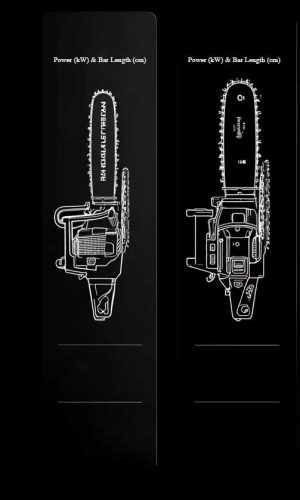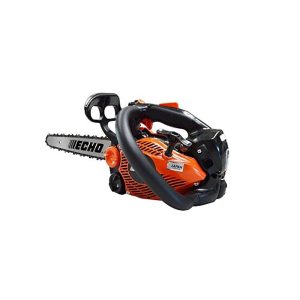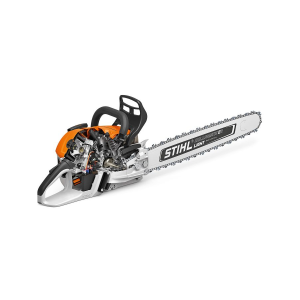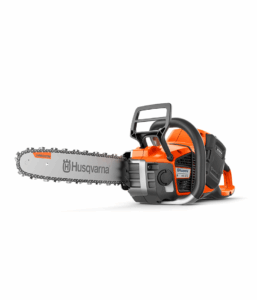Petrol Chainsaws: Stihl, Husqvarna & More for Woodcutting
Performance, runtime and reliability: explore our pick of petrol chainsaws from Stihl, Husqvarna & co, with guides, reviews and gear.Compare bar lengths and features, get maintenance and sharpening tips, and choose essential PPE for safer, more efficient cutting !
Pick the petrol chainsaw that’s made for you !
In 2025, the best petrol chainsaws stand out for their cutting performance, durability, and ease of handling. This comparison reviews the top models in detail and provides clear, practical opinions to guide your decision. Whether you need a lightweight saw for pruning, a high‑power machine for felling, or outstanding value for money,you’ll find the petrol chainsaw here that perfectly matches your needs and your budget.
Comparison of Leading Brands

STIHL
Broad range from homeowner to elite professional; strong dealer network, excellent AV, durable pro chassis.

Husqvarna
Known for fast cutter speed, balance, and advanced filtration; popular with forestry and arb pros.
How to choose the right petrol chainsaw ?
Don’t worry choosing a petrol or a electric chainsaw can feel complex with so many models and brands. The good news is you’re not on your own. Our seasoned experts are ready to guide you with reviews and side‑by‑side comparisons, so you buy confidently and get the right tool.

More Comparison of Leading Brands and Models
The market is mature, with established brands offering distinct strengths. Specifications matter, but so do parts availability, dealer support, and after‑sales service.
Concrete Comparison Criteria: Power, Bar Length, Weight, Options, Warranty, Service Availability
- Power‑to‑weight: For all‑rounders, target ≥2.5 kW around 5–6 kg (without fuel) and check balance with the intended bar/chain.
- Filtration: Cyclone pre‑separation extends filter life in dusty conditions.
- Carburation: Auto‑tune suits variable environments; manual tuning allows expert optimisation and field serviceability.
- Options: Heated handles, captive nuts, side tensioner, tool‑less caps, winter/summer covers, large‑mesh filters for fine dust.
- Warranty and service: Confirm local dealer capability, spares lead times, and availability of consumables (bars, chains, sprockets, AV mounts).

By Use Segment: Pruning/Top‑Handle, Domestic/Maintenance, Farm/Semi‑Pro, Pro Felling
- Top‑handle pruning saws (qualified arborists only): Compact, high chain speed; strictly for trained in‑tree use.
- Domestic/maintenance: 30–45 cc, 12–16″ bars, easy starting, low vibration—ideal for garden storm clean‑up and routine firewood.
- Farm/semi‑pro: 45–60 cc, 16–20″ bars; tougher crankcases, better filtration, higher duty cycles for estates and smallholdings.
- Professional felling/ground saws: 60–90+ cc, 18–28″+ bars; magnesium cases, full‑wrap handle options, pro‑grade AV for daily forestry.













How to Choose the Right Petrol Chainsaw for Your Needs
Once you’ve settled on a petrol chainsaw brand, it’s time to choose the specific saw that fits your work, budget and maintenance preferences.
Identify Your Scenarios: Bucking Firewood, Limbing, Occasional or Intensive Felling
- Firewood bucking: Frequent cross‑cuts of 15–35 cm logs; a 45–55 cc saw with a 16–18″ bar is a sweet spot.
- Limbing/snedding: Many short, precise cuts—prioritise low weight, slim bar, and responsive throttle (40–50 cc, 13–16″).
- Occasional small felling: 45–60 cc with 16–20″ depending on species and diameter.
- Intensive forestry: 60–90+ cc matched to bar length and local hardwood density; consider heated handles and full‑wrap grips for winter.
- Arborist crown work (qualified users only): Dedicated top‑handle, short bar, high chain speed, and tether points.

Match Bar and Chain to the Wood: Species, Diameter, Cleanliness
- Hardwoods vs softwoods: Full‑chisel chains cut fast in clean hardwood; semi‑chisel holds an edge longer in dirty or frozen wood.
- Pitch and gauge: Smaller pitch (.325″, 3/8″ low‑profile) suits mid‑size saws for smooth cutting; standard 3/8″ suits larger powerheads.
- Dirty wood, bark inclusions, sand: Use semi‑chisel, expect more frequent sharpening; keep a scrench and files handy.
- Bar choice: Sprocket‑nose for speed and cooler running; narrow‑kerf bars reduce load on mid‑size saws.
Essential Accessories: Spare Chains, Files/Grinder, Bar Oil, Mixing Can, PPE
- Cutting kit: At least two spare chains, correctly sized round file and flat file with depth‑gauge guide, resin wedges, felling lever, scrench.
- Fluids: Graduated mixing bottle or can, stabiliser if using pump petrol, season‑appropriate bar oil.
- PPE: Chainsaw helmet with visor, hearing protection, EN‑rated chainsaw trousers, cut‑resistant gloves, safety boots with toe and cut protection.

Most recent articles
Help & FAQs
Choose petrol when you need:
- Maximum cutting performance in hardwoods and large diameters.
- All‑day runtime far from power sources.
- Compatibility with longer bars and aggressive chain set‑ups.
Choose electric/battery when you need lower noise, instant start, minimal engine maintenance, or when you work near neighbours and within short, intermittent sessions.
Most modern engines specify 50:1 using a high‑quality, low‑ash, fully synthetic two‑stroke oil meeting JASO FD/ISO‑L‑EGD. Measure accurately with a graduated bottle. If your manual states otherwise, follow it. Use fresh petrol; consider alkylate fuel for cleaner running and better storage stability.
depth‑gauge settings. Remedies: keep timber clean and elevated, maintain correct raker height, ensure ample bar‑oil flow, and sharpen little and often using the correct file and angles. Switch to semi‑chisel for dirty or frozen wood.
- Plan work during acceptable daytime hours, communicate with neighbours, ensure the muffler and spark arrestor are intact, and consider a smaller bar and semi‑chisel chain to reduce harshness. For frequent neighbourhood tasks, a cordless saw may cover early/late jobs, reserving petrol for heavy cuts.


